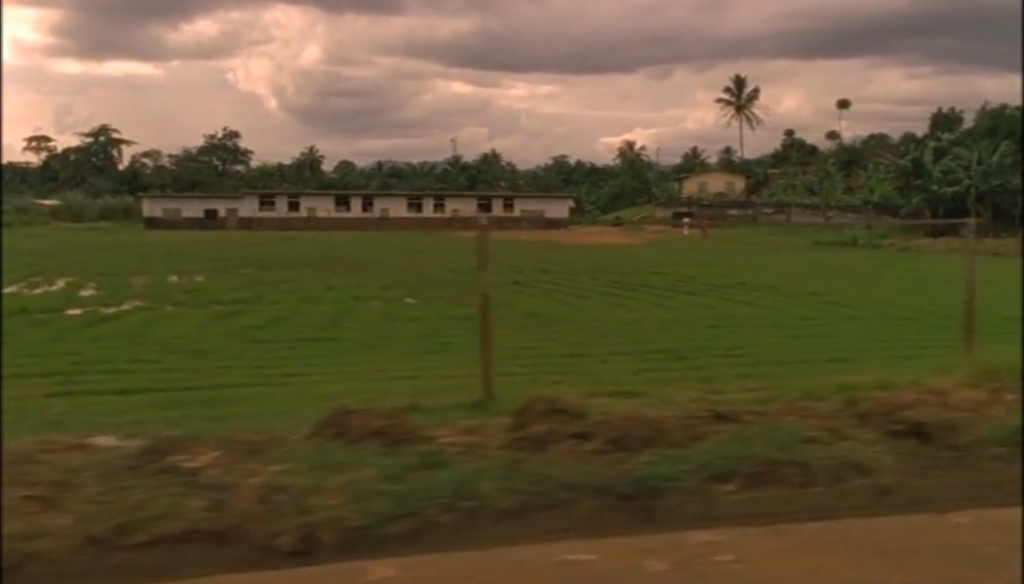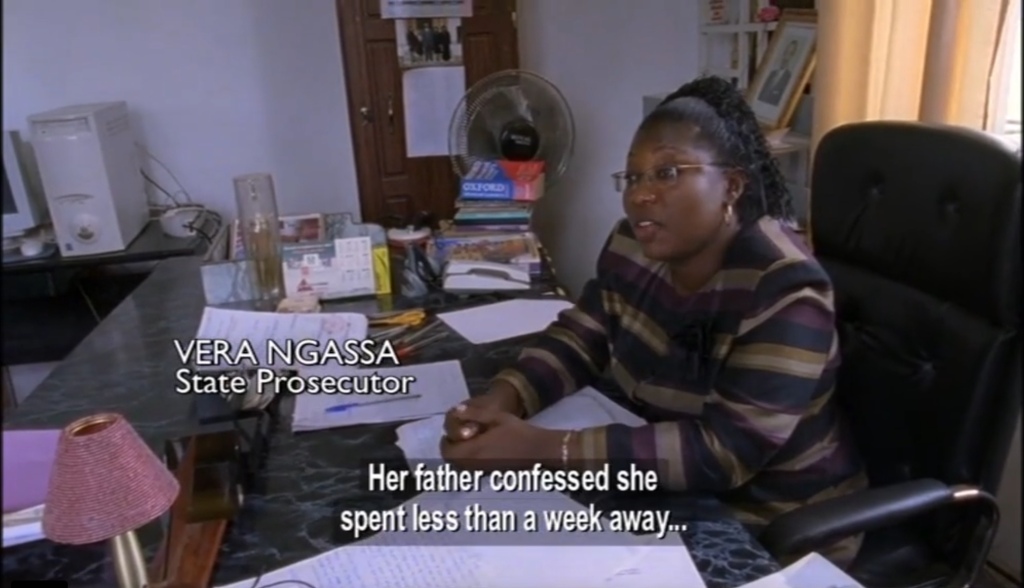Throughout the opening sequence of Sisters in Law, Kim Longinotto employs the key elements of film form in a wide variety of ways in order to produce an unobtrusive observational documentary.
Firstly, Longinotto employs the use of a portable handheld camera throughout the duration of the film. The sequence opens with a wide shot out of a car window that exhibits the rural, poverty-stricken landscape. It could be argued that Longinotto has chosen to use a smaller, more portable camera due to the fact that it is less conspicuous than a tripod. Therefore, the subjects’ actions portrayed throughout the documentary will be more genuine in theory. The vistas are lush and the weather is overcast – perhaps challenging the viewer’s preconceived notions of West Africa. Throughout this long take, a non-diegetic score is present in the mix – a plucked acoustic guitar that evokes a sense of pastoral imagery. As the score gradually lowers in the mix, the diegetic ambient street noise of Kumba enters. From this point forward, every sound in the mix is both diegetic and recorded on set. Alongside this, the lighting is all naturally captured and is merely a reflection of reality. All of the mise-en-scène found within each scene is naturally occurring in order to display an entirely authentic depiction of the scenarios. It is also important to make note of the fact that no contextual information is explicitly stated to the viewer.

As Longinotto travels further into the village, it becomes clear that an example of temporal editing is implemented. Longinotto’s use of hard cuts exhibit the passing of time as the village becomes ever closer. As she reaches her destination, Longinotto employs her first of many uses of camera panning – a typically unorthodox technique within filmmaking. In the case of Sisters in Law, panning is used in order to recreate the feeling of a head turning to take in its surroundings. Through this, the camera acts as the proxy for the viewer over the course of the film.
Within the village, Longinotto captures the actions of the documentary subjects in a variety of ways. She utilises a number of spontaneous camera movements – tracking people’s movements by tilting up and down. Alongside this, when a person starts speaking, Longinotto will usually pan the camera in order to focus upon them, reminiscent of eyes following a conversation. Scenes are mostly captured with a two camera setup, operated by Kim Longinotto herself, as well as co-director Florence Ayisi. Through this, each situation can be aptly captured by two opposite angles – Longinotto later cutting between the footage appropriately.
The residents of Kumba mostly speak in a form of Pidgin English. This involves the use of fragmented English phrases which are interspersed with a multitude of African tongues. Due to this, almost all of the events portrayed are accompanied by English subtitles. As we are introduced to Vera Ngassa, the state prosecutor, a subtle title card displays her name – a rare example of explicit information provided to the viewer. The conversation between the prosecutor and the couple ensues, during which Longinotto employs the zoom feature in real time to focus in on a closeup of Vera. Due to autofocus taking effect, the footage briefly goes out of focus before refocusing on the closeup. This demonstrates to us Longinotto’s priority of accuracy and authenticity over aesthetic perfection in the case of this film.

Throughout the sequence, editing is visible and present – but unobtrusive. Used in order to break up the frequent long takes which exhibit the passing of time, Longinotto’s use of editing acts as a compression of events rather than a manipulation. It is clear to see that in the example of this case, the woman reporting her abusive relationship is acting genuinely. She takes no notice of the camera’s presence and her sincere demeanour illustrates that she is exclusively concerned with her serious legal matter. In addition to this, Vera Ngassa’s disposition is strict, impartial and austere. This aids Longinotto’s aim of presenting female strength and empowerment within an oppressed and poverty-stricken environment. Finally, it is important to make note of the fact that each legal case is interspersed with brief, ambient scenes which display domestic life within the village. Throughout these, Longinotto will typically film in a single location and capture each and every event that occurs, even seemingly trivial scenarios. In effect, this contextualises the setting and cultural characteristics of the Cameroonian village of Kumba.